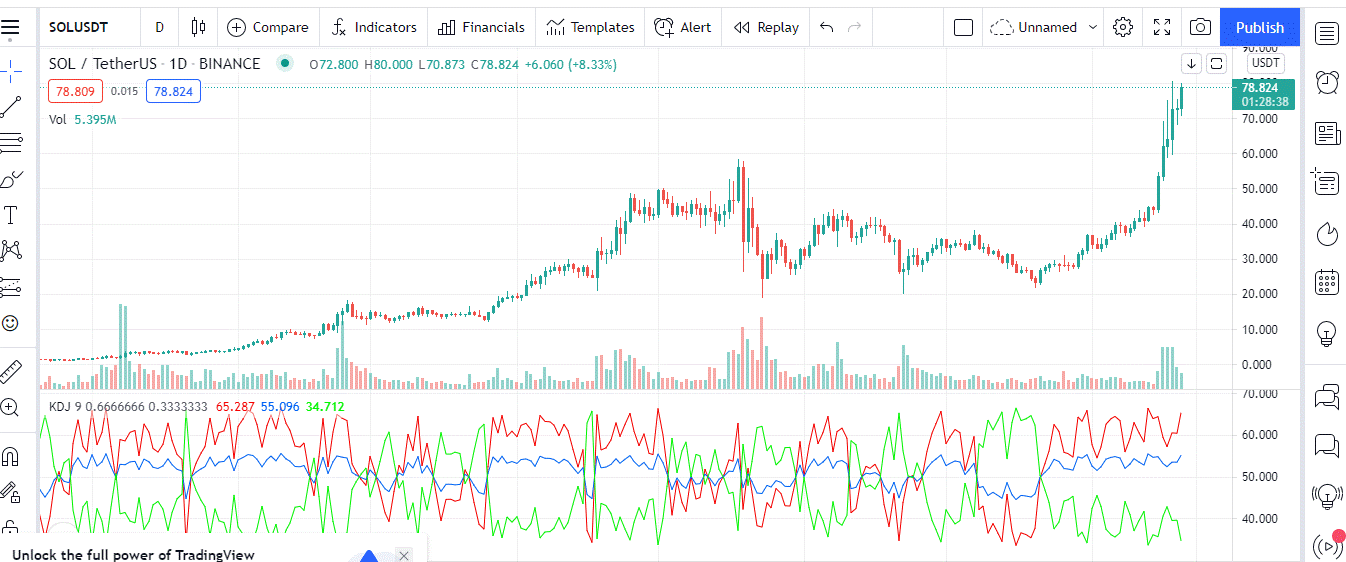.png)
Introduction
With the ever evolving crypto space comes the rising problem of inadequate indicators and tools capable of keeping up with the trend and aiding adequate research on assets( which has been explained earlier to be a vital step before engaging on any particular trade). indicators and other tools serve as guidelines to traders while also offering the service of providing background information on particular assets so as to enable the trader make better choices on how to place trade. However, the crypto space being the ever growing and changing space (changes in prices, change in dominance etc.) demands that tools and indicators evolves too, hence we have the constant introduction of new indicators and tools all offering up increased efficiency. One of these indicators being the topic of discussion today;
The Random Index (KDJ)

Random Index
The random index is one of the indicators introduced to the crypto market space, random index or KDJ index as its usually called is a derivative of stochastic oscillator indicator differing in only an extra J line. this is a technical tool or indicator aimed at aiding the trader place a trade by offering critical analysis while predicting changes in shock trends. It is commonly used in the analysis of short term stock because of its practical nature.
The American George Lane was behind it. It makes use of the momentum concept, strength index and moving average to achieve its goals of assisting the investor. The William (WR) theory serves as the bed rock for the design idea and calculation formula of the random index, however the random index has proved more valuable than the WR index. The KDJ indicator is commonly used to judge the buying and selling of signals unlike the WR indicator which judges over bought or over sold stocks.
setting up your indicator in in four easy steps:
-Go to ‘Indicators’ (bottom left corner of the screen);
-Go to the ‘Trend’ tab;
-Choose KDJ from the list of available options;
-Click Apply without changing the settings.

The random index is calculated using the values of high, low and close price changes of the day. It consists of three lines; the K line, the D line, the J line, which when they all meet forms a signal.
Calculation of the KDJ index
In calculating the KDJ the first step is to calculate for the RSV value before finding the K, D & J values.
RSV = (Cn – Ln) / (Hn – Ln) * 100
with Ln being the lowest price in N periods,
Hn being the highest price in N periods, which gives the highest price
Cn being the closing price in N-th period, hence the closing price after observation period
RSV being the ultimate random index value fuctuating from 1-100
with that found proceed to calculate the K, D and J values
Kn = 2/3 * Kn_1 + 1/3 * RSV
Dn = 2/3 * Dn_1 + 1/3 * Kn
Jn = 3Kn – 2Dn
kn being k value of present day
kn_1 being the k value of the previous day
Dn being the present day D value
Dn-1 being the D valuve of the previous day
Jn being the J value pf the present day
RSV being the already calculated RSV value of the day'

Reliability of KDJ
Bearing in mind that no indicator offers 100% efficiency as over time even the leading indicators fail, the random index is relatively reliable as it offers various features aiding the ease of trading. such features include; providing false signals when the market is flat, determining the market trend and optimal entries, despite being relatively reliable the random index is strongest in the analysis of trending markets than that of the short time frame chart analysis.
In essence, scalpers will find it more profitable using the KDJ than swing traders. However, it is advised to find other indicators that compliment the action of the KDJ. This way, you have two or more confirmation, before entering a trade, as different parameters from different indicators that use unique formula, arriving at the same forecast increases your chances of success.

How is the random index added to a chart and what are the recommended parameters?
Adding the random index to a chart can be done using the following steps
go to tradingview.com. this should lead you to a page interface as such

Signing in/up on tradingview platform which leads you to a page like this

next is to click on the chart icon on the header list and select on the chart of your choice. for this example i'll be entering the SOLUSDT chart

then click on the indicator(Fx) icon from the list of icons displayed on the page header

which should bring out an indication and strategies page which you search for the random index indicator

search for the KDJ indicator and apply it

your chart should already reflect the indicator as such;

The recommended parameters are;
n= the number of observation days
a = the number of days for smoothing Kn
b = the number of days for smoothing Dn.
Usually, the market calculation of the KDJ is by using parameter triplets; (9, 3, 3)
n=3
a=3
b=3

Differences between KDJ, ADX, and ATR
KDJ indicator
The KDJ indicator has been defines above many times. It is an indicator consisting of 3 MAs that help us weigh strength of the price action, reversal, shocks etc.
ADX
The ADX indicator by J. Wilder was built to measure the strength of a trend. Since the DI+ and DI- lines are used together with the ADX, both trend strength and direction can be measured using this indicator.
ATR indicator.
The ATR ( Average True Range) indicator determines volatility in the market. It compares the buying climaxes and selling climazes of a particular commodity and weighs price flunctuations.
The differences shall be discussed in various headers;
Default settings :
They all have different market calculation default settings with the KDJ being 9,3,3; ADX being 14,14,14; and ATR being 14The moving averages:
The KDJ indicator has three MAs; K,D, & J; with ADX havind the ADX MA and accommodating the D+ and d- lines; and the ATR having just an MAIndication:
The KDJ indicates the when an asset was overbought and over sold as well as indicating the trend reversal with the market entry and exit entry; ADX indicates the strongest and weakest points of the price fluctuations; while ATR indicates the volatility of assets over time in the market space.Developers:
The KDJ was invented by George Lane while the ADX & ATR was invented by J. Welles Wilder

Using The Signals Of The Random Index To Buy And Sell Any Two Cryptocurrencies.
SELLING
The J line cuts across the KD to start trading below. This signals a reversal to a downtrend and I place my entry

Few minutes later, the indicator proves true, I'm in profit.

BUYING
The J line then cut across the K and D lines, upwards. I place my buy but the unfortunately large spread takes it far from my entry point.

Few minutes later, after price almost hit my stoploss, the indicator seems to have made the right call. I would be in profits if not for the large spread.


CONCLUSION
The KDJ indicator from the tests I ran can be a powerful tool is well used. The accuracy in predicting short time changes is topnotch. However, Traders should endeavor to use proper risk management, and also trade with money they can afford to lose, because as much as we try to stack the odds in our favour, no one really knows what the market will do next.
Even if not as a trading strategy, the KDJ can provide an exit strategy, as the crosses tell of a possible reversal, this can be used as a signal to take profit or stop loss for an already open trade.
I enjoyed the lecture from @asaj and I hope you all enjoyed reading this article. See you next season.
Superb performance @alphafx!
Thanks for performing the above task in the eighth week of Steemit Crypto Academy Season 3. The time and effort put into this work is appreciated. Hence, you have scored 8.5 out of 10. Here are the details:
Remarks
Overall, you have displayed a good understanding of the topic. You have performed the assigned task excellently. However, you analysed and traded only Bitcoin.
That said, this is good work. Thanks again for your contributing your time and effort to the academy.
Downvoting a post can decrease pending rewards and make it less visible. Common reasons:
Submit
The Speedyindex indexer is a powerful tool designed to enhance your website’s search engine optimization (SEO) by ensuring fast and efficient indexing. With its user-friendly interface, Speedyindex simplifies the process of getting your web pages indexed by search engines like Google, Bing, and Yahoo. By quickly indexing new or updated content, it helps improve your website’s visibility, boosting traffic and rankings. This tool is ideal for marketers, bloggers, and businesses seeking an edge in the competitive online landscape. Rely on the Speedyindex indexer to save time, improve your site’s performance, and ensure your content reaches its audience faster.
Downvoting a post can decrease pending rewards and make it less visible. Common reasons:
Submit
The Stads e-bike is revolutionizing the way we navigate through cities. Designed for efficiency and sustainability, this electric bike offers a smooth and eco-friendly alternative to traditional transportation. With its powerful motor, the Stads e-bike makes commuting effortless, even in busy urban areas. It’s perfect for those who seek a greener way to travel without sacrificing speed or comfort. Whether you’re heading to work or running errands, the Stads e-bike provides a reliable, cost-effective solution for modern urban mobility. Join the e-bike movement and embrace the future with the Stads e-bike.
Downvoting a post can decrease pending rewards and make it less visible. Common reasons:
Submit